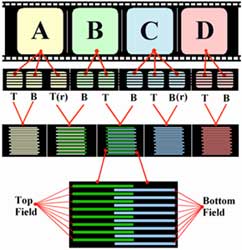Advanced video playback
For the guys and gals out there that use their PCs to watch DVDs in any form, this is for you. The advanced quality features that are included in Catalyst 5.13 include Temporal recursive de-noise, Multi-format pull-down detection and an improved Vector adaptive deinterlacing capability. Cat 5.13 uses the power of the ATI graphics architecture to accelerate these features that might not otherwise be possible in CPU / software.So far, so many buzzwords. What does all of this mean?
Vector Adaptive de-interlacing: A lot of video content, such as some DVD content, is interlaced - that is, it contains enough frame data to refresh the half the display at once. This is as opposed to progressive, which refreshes the whole of the display at once - you will see this differentiated in the 'i' and 'p' suffixes to video standards, such as '1080i' for a horizontal resolution of 1080 interlaced and '1080p' for progressive. Interlaced video is designed for TV, where as PC monitors are progressive. For optimum video quality on a PC monitor, interlaced video therefore needs de-interlacing - however, this is a complex process, and it's possible for it to be done fairly badly. The new Avivo technology includes an updated algorithm that uses motion detection to work out the best way to perform the calculations and results in great image quality.
Temporal recursive de-noise: Noise occurs in videos that are badly encoded. Load up a 'bad' (small file size, often) video - you'll see the some areas, especially large black areas, have dots of colour around them. The new Avivo architecture works to pull this noise out, giving you a better video.

Multi-format pull-down detection: Explaining pull-down is something of a nightmare, but here we go. Interlaced video is designed for a TV - because a TV only refreshes half a frame a once, it's a perfect match for interlaced video. However, a PC monitor can refresh the whole picture at once, which can result in bad picture quality.
This bad picture quality is exacerbated by the fact that most video content in the US is subject to 3:2 pull-down correction. Simply put, NTSC video is recorded at 24 frames a second, but the playback standard for NTSC is 30 frames a second. When playing back video, the video has to be chopped and changed to fit it into 30 frames - this is the process of 3:2 correction. For more details on this process, you can check out this page on Divx.com, which explains things really simply.
This 3:2 correction can make video look atrocious on PCs. Avivo utilises some cool algorithms to get rid of the artefacting and make video look better.
Quantifying quality
How do we know that it's better quality? ATI have been showcasing a benchmark called HQV that attempts to quantify how good video playback quality is. The benchmark is the result of a collaboration between US publications including ExtremeTech, DesignTechnica, Sound & Vision and the New York Times. It uses stock clips to help you evaluate and quantify playback components including cadence detection, de-noise, detail enhancement and de-interlacing. ATI showed us the benchmark running on identical Dell XPS laptops - the only difference was that one Dell was running a 7800 mobile, and the other was running an unreleased X1800 mobile part. Based on these platforms, we saw ATI's video quality come out at almost double the score of Nvidia's in the HQV benchmark. We haven't yet had a chance to test this independently, but you can rest assured that we will as soon as possible.
MSI MPG Velox 100R Chassis Review
October 14 2021 | 15:04







Want to comment? Please log in.